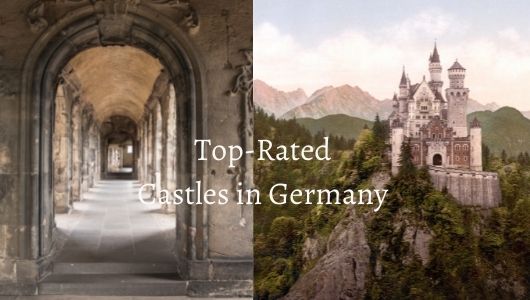Many of Germany’s castles are placed high above the surrounding hills and even cliff edges, gracefully overlooking the local fields.
Germany has the world’s longest castle complex. While some have been untouched by time, others have been in the centre of bloody conflicts and wars, and have been thankfully restored to recount the stories of the past.
You may be sure to find some of the world’s most stunning castles in Germany, from ancient strongholds to noble palaces, in a country as large and rich in history as Germany. Most are full of history and some are still owned by the original families, and they’re strewn around the country.
Tourists in Germany have a wide range of options, with up to 20,000 castles to select from.
Neuschwanstein Castle
Neuschwanstein Castle, Germany’s most photographed structure, is also one of Europe’s most popular tourist destinations.
This fairy-tale castle, nestled among the majestic grandeur of the Bavarian Alps near the town of Fussen, served as the inspiration for Walt Disney’s Sleeping Beauty Castle.
It was built in the late 1800s, but unlike most castles, it was never built for defence. Instead, Ludwig II of Bavaria built this castle as a fancy getaway.
Every chamber in the castle is adorned with dazzling chandeliers and magnificent paintings, while the third storey is dedicated to Ludwig’s infatuation with swan scenes from operas by the famed composer Richard Wagner, whom Ludwig liked much.
Eltz Castle
Eltz Castle in Western Germany is one of the German castles that has grown to prominence in recent years as a result of social media. Eltz Castle is a favourite of many photographers and landscape enthusiasts on Instagram, thanks to its lovely ambiance surrounded by thick, dark woods.
Even during the most turbulent historical periods, this mediaeval fortress, which is unique to the Rhineland-Palatinate region where it is located, was never destroyed. The castle is still owned by the original family today.
Thousands of tourists visit each month because of its unique appearance and the fact that it is located within a valley but still perched on a hill.
You can’t help but be impressed and in wonder as you go towards the castle through the cobblestone gatehouse entrance. It’s as though you’ve stepped into a fairytale.
Hohenzollern castle
The castle, which sits atop Mount Hohenzollern, dates back to the 11th century. Only the chapel remains from the ancient fortress, which was demolished over the centuries.
King Frederick William IV of Prussia built the current castle in the mid-nineteenth century.
The ancestral residence of the Hohenzollern family, which has produced emperors and kings, is located 30 miles south of Stuttgart.
Today, the castle serves as a museum. It is brimming with valuables, including Prussian kings’ crowns and Frederick the Great’s outfit. It is privately held and is one of Germany’s most visited castles.
Schwerin Castle
Schwerin Castle, which was erected between 1847 and 1857 and once housed grand dukes before becoming state-owned, was built between 1847 and 1857. In the past, Schwerin Castle served as a teachers’ college, a hospital, and a museum.
Schwerin Castle is made up of a series of turrets with golden domes and gleaming pinnacles that are surrounded by lakes and woodlands.
The architectural structure of the castle is widely admired, and its meticulous attention to detail has made Schwerin Castle one of Europe’s most important architectural accomplishments of the romantic historicism era.
Take a stroll through the beautiful orangery of this famous German castle and marvel at the wonderful arrangement of parkways, flower beds, and statues.
Schwerin Castle’s grounds, regarded as one of northern Germany’s most spectacular baroque gardens, combine aspects of the English landscape, Italian architecture, and French design.
Admire the majestic living rooms, the throne chamber, exquisite ballrooms, a gallery of paintings, the ducal collection of hunting and parade weapons, fine porcelain, and silver on show at the castle’s museum.
Lichtenstein Castle
Count Wilhelm of Württemberg, Duke of Urach, was inspired by Wilhelm Hauff’s romantic novel Lichtenstein and had Lichtenstein Stronghold built on the ancient foundation walls of a medieval knights’ castle.
Lichtenstein Castle, located an hour south of Stuttgart, is a lovely hunting castle with panoramic views of the Echaz Valley and Swabian Alps. Lichtenstein Castle and its neo-Gothic architecture are a superb homage to the Middle Ages, with great attention to detail.
Despite the fact that Germany has a large number of castles, this one is quite popular among German tourists.
Marburg Castle
Marburg Castle, also known as Marburger Schloss, rises majestically above Marburg’s old town and has a fascinating history. Since the original Medieval fortification, this Landgrave castle has altered a lot and sits in a vital location.
The chapel edifice, together with the great hall, is considered one of the finest Gothic halls in Central European castle architecture. The castle incorporates Gothic and late-Gothic elements, as well as Renaissance additions.
The Marburg Castle now serves as the home of the Museum for Cultural History. Marburg Castle is famous for its part in the uncovering of the infamous Marburg Files, which held significant Nazi government secrets.
Within Marburg Castle, the newly discovered files were examined.
Heidelbeg Castle
Heidelbeg Castle, which dominates the vista of Heidelberg’s old centre, is placed 80 metres (260 feet) atop the northern part of a hillside.
The ruins of the castle are one of the most significant Renaissance constructions north of the Alps. Since the construction of the first castle structure in the 13th century, it has had a long and violent history.
The castle was struck by lightning in 1764, and its stones were used to build new residences in Heidelberg after it was completely destroyed during the Thirty Years War and afterward by the French in the 17th century.
The castle’s appeal is enhanced by the range of architectural styles that have resulted from the later rebuilding.
Reichsburg or Cochem Castle
The ancient castle from the 12th century, Reichsburg or Cochem Castle, which overlooks the lovely Moselle River and the lush green winemaking region of Rhineland-Palatinate in Western Germany, is not the current one.
In the late 17th century, Louis XIV and his soldiers demolished the old castle. It remained in ruins until the 19th century, when Louis Ravené, a renowned Berlin businessman, purchased the ruins and reconstructed the castle.
The first castle was constructed in the Romanesque style. The new castle, on the other hand, was mostly rebuilt in a neo-Gothic style, with Romanesque and Gothic components in places like the Octagonal Tower and the so-called Witches Tower.
Louis Ravené’s son was forced to sell the castle to the Prussian Ministry of Justice during World War II, and the castle was occupied by a Nazi government-run law school.
After the war, the state of Rhineland-Palatinate controlled the castle, which was later purchased by the city of Cochem.
Wernigerode Castle
Wernigerode Castle is located in Saxony-Harz Anhalt’s Mountains. It is one of the region’s most popular tourist destinations.
There was previously a mediaeval fort here, like with many castles. It was then restored as a Renaissance castle, but after the disastrous consequences of the Thirty Years War, Count Ernest of Stolberg-Wernigerode repaired it in a Baroque design.
The castle comprises three gardens and parks, and sections of it have been open to the public since 1930. The castle has approximately 50 rooms, and marriages can be held in the castle church as well as the smokers’ salon.
Wartburg Castle
Wartburg Castle, described as “an outstanding monument of the feudal period in central Europe” by UNESCO, is also notable for being the site where Martin Luther translated the New Testament into German.
The translation heralded the birth of a unified and accessible written German language, which is far more important than its religious value.
Wartburg Castle was erected in the second half of the 12th century and still has some original elements from its medieval era, but most of it is meticulously researched and rebuilt in the 19th-century.
As a result, you can view it as it would have appeared during its heyday in the Middle Ages when it was at its most powerful and influential. Its strategic location atop a 400-meter ridge emphasises its significance.
A courtyard encircled by half-timbered structures and battlemented parapets is reached through a medieval drawbridge. Beautifully renovated halls and rooms bring the medieval and Renaissance centuries to life.
The castle’s roughly 9,000 antique pieces are used in period furniture and other displays, and the art collection includes works by Lucas Cranach the Elder.

